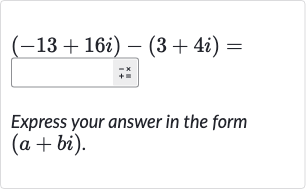AI tutor
Full solution
Q. Express your answer in the form .
- Identify complex numbers: Identify the real and imaginary parts of each complex number.The first complex number is , where is the real part and is the imaginary part.The second complex number is , where is the real part and is the imaginary part.
- Subtract real parts: Subtract the real parts of the complex numbers.Subtract the real part of the second complex number from the real part of the first complex number.Real part calculation:
- Subtract imaginary parts: Subtract the imaginary parts of the complex numbers.Subtract the imaginary part of the second complex number from the imaginary part of the first complex number.Imaginary part calculation:
- Combine real and imaginary parts: Combine the results of the real and imaginary parts.Combine the results from Step and Step to get the final answer in the form .Final answer: = + i
More problems from Composition of linear functions: find an equation
QuestionGet tutor help

